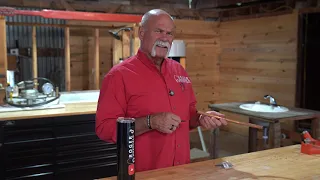In Should You Flush Your Water Heater | Plumbing 101, we explore one of the most common questions homeowners ask: is it really necessary to flush a water heater? The short answer is that it can be incredibly beneficial—but only if you start doing it from day one. If you wait too long, you could actually cause more harm than good. In this blog post, we’ll look at when flushing makes sense, how to do it properly, and why it can save you money in the long run.
Why Flushing Your Water Heater Matters
A typical water heater works by using either a gas burner or electric elements to heat the water stored in the tank. Over time, calcium, magnesium, and other sediments can settle at the bottom. Picture piling a few plates on top of a stove burner before placing your pot on top—heating that pot takes much longer because the heat has to travel through extra material. The same principle applies to your water heater. When sediment accumulates inside the tank, it acts like an insulating layer between the burner (or elements) and the water, which can:
- Make your water heater take longer to heat water.
- Increase your energy bills, as the heater works harder.
- Cause extra wear and tear, shortening your heater’s lifespan.
In contrast, flushing can clear out these deposits, allowing your water heater to operate more efficiently. If done annually, flushing can help your tank last longer and save you money on monthly energy costs. However, it’s critical to understand when and how to flush a heater—especially if it’s older or has never been flushed before.
The Annual Flush: Best Practice or Bad Idea?
Most plumbers agree that if you start flushing your heater within the first couple of years of its life, it should be done once a year. This regular maintenance prevents sediment from accumulating in the first place. Think of it like changing your car’s oil: you keep everything running smoothly and avoid expensive repairs down the line.
But what if your water heater is already four or five years old and has never been flushed?
When It Might Be Too Late
If your tank has gone four or more years without a flush, you could risk stirring up large amounts of sediment that has settled and caked onto the bottom and sides. Once disturbed, these deposits could float around and potentially open up micro-cracks or pinhole leaks that were previously sealed off by the sediment itself. In other words, flushing an older, neglected water heater can sometimes do more harm than good.
Rule of Thumb:
- Under 3 years old: Flushing is typically safe and recommended.
- 3–4 years old: Proceed with caution, or consult a plumber.
- Over 4 years old (never flushed): You may opt to leave it alone and start planning for a replacement if you suspect heavy sediment buildup.
Signs Your Water Heater Needs Attention
Whether you plan to flush your water heater or not, keep an eye on certain warning signs that could indicate sediment buildup or other issues:
- White Powdery Residue or Stains
If you notice a chalky film around faucets or showerheads (often from calcium or magnesium), your water could be high in minerals, leading to quicker buildup inside your tank. - Rusty or Discolored Water
Corroded metal inside an older tank can create rusty water. This could also be a sign that your anode rod is depleted and no longer protecting the tank walls from corrosion. - Strange Noises or Clogged Valves
Knocking or rumbling sounds from the tank often result from sediment shifting during heating. In faucets and toilets, particles can clog valves, causing noisy or inefficient operation. - Leaking Temperature and Pressure (T&P) Relief Valve
If you see a continuous drip from the copper tube that runs from the T&P valve, you’re wasting hot water—and money. That valve might be opening due to excessive temperature, pressure, or sediment interfering with normal operation. - Leaks or Tank Damage
Obviously, any sign of leaking water around your tank means you should investigate immediately. Leaks often occur at connections, valves, or the base of the tank. - Reduced Efficiency
If you notice your hot water running out faster than usual, or you’ve had a spike in energy bills, sediment might be limiting your heater’s capacity and efficiency.
Understanding the Sacrificial Anode Rod
Every standard water heater has a sacrificial anode rod inside the tank. Typically made of magnesium or aluminum, it’s designed to corrode before the steel lining of the tank. This rod “sacrifices” itself to protect the interior from rust and leaks. Over time, the anode rod’s material can deplete. When that rod is heavily compromised, the sediment layer often becomes more pronounced inside the tank.
- Flushing Dilemma: If you’ve never flushed your tank and the anode rod is already in bad shape, breaking up the hardened sediment at the bottom might leave the steel tank walls exposed and prone to new leaks.
- Maintenance Tip: If you catch the problem early, you can replace the anode rod and maintain regular flushing without risking tank damage.
Avoiding Warranty Issues
Many homeowners assume that if they buy a water heater with a long-term warranty, they’re covered in case of tank failure. However, carefully read the fine print. Many warranties explicitly require treated water (such as softened water or filtration) to maintain coverage. If you live in an area with hard water, the manufacturer might consider damage from excessive mineral buildup as a maintenance issue, often voiding the warranty. Similarly, some toilets and other fixtures come with disclaimers about hard water voiding their warranty.
If you’re in a region known for hard water, installing a water treatment system—like a whole-house water softener or a filtration system—can greatly reduce these risks. That way, you’re less likely to have big mineral deposits and less likely to run into warranty disputes.
How to Flush an Older Heater if You Absolutely Must
Sometimes, you’ll find yourself in a situation where you feel you have to flush an older water heater. Maybe the bottom is so full of sediment that you suspect the unit has very little capacity left. If you decide to go forward, proceed with extreme caution:
- Shut Off Power and Water Supply
Turn the gas control to “pilot” or flip the breaker for an electric heater. Close the cold-water inlet valve to the tank. - Open the Drain Valve Slowly
Attach a hose to the drain valve and open it very gently. Keep the other end of the hose in a safe area (driveway or drain). - Monitor the Flow
If water flows freely, you may gradually open the drain valve more. If it barely drips or stops, you may have a large blockage of mineral deposits. - Use a Coat Hanger or Small Tool
You can try gently prodding the drain opening to dislodge sediment. However, this is risky, as it might break up large chunks that can shift inside. - Consider Removing the Top Connections
In extreme cases, plumbers sometimes remove the dielectric nipple on the cold inlet and lower a tube inside the tank to pump the water out from above. This method can be safer for a severely clogged drain valve. - Refill Slowly
After draining, open the cold-water inlet valve carefully. Let water flow through the tank a couple of times to rinse out any remaining loose sediment before powering the unit back on.
Even with these steps, there’s no guarantee you won’t damage an older tank. The risk is part of flushing a water heater that’s gone many years without maintenance.
Tankless Water Heaters Need Love, Too
Don’t forget about tankless water heaters. Their heat exchanger is typically only a few inches in diameter. A quarter-inch of scale inside that exchanger drastically reduces efficiency. In fact, most tankless water heater manufacturers recommend annual descaling, especially in areas with hard water. This process involves:
- Turning off power and water to the unit.
- Connecting hoses to a flush kit.
- Circulating a descaling solution (often white vinegar or a commercial cleaner) through the heat exchanger.
- Flushing it with clean water afterward.
If you skip this maintenance, you might see reduced performance, longer waits for hot water, and eventually, error codes or breakdowns. As with traditional tanks, ignoring routine care can lead to losing warranty coverage.
Choose a Better Drain Valve
When purchasing a new water heater, ask the installer for a brass drain valve instead of the standard plastic one. Even better, have them install a full-port ball valve with hose threads. This makes future flushes much easier. Plastic valves are more prone to blockage and can become brittle over time. A high-quality drain valve can be a simple, affordable upgrade that pays off in the long run.
Sponsored by Leak Pro
This content is sponsored by Leak Pro, a tool that helps professional plumbers locate and fix leaks more efficiently. As part of any leak detection, you’d also inspect the water heater to see if it’s contributing to the issue—another reason it’s vital to maintain and flush your water heater properly when appropriate. Learn more at www.leak-pro.com.
Final Thoughts
For homeowners asking, “Should you flush your water heater?” the best answer is: yes, but only if you start early and do it regularly. Flushing an older unit that’s never been serviced can lead to complications, including leaks or valve clogs. However, if your water heater is relatively new—or you’ve flushed it yearly since installation—you can enjoy the benefits of faster heating, lower energy bills, and a longer lifespan for your unit.
No matter which route you choose, keep an eye out for signs of sediment buildup like noisy operation, rusty water, or a constantly dripping T&P relief valve. And if you live in a hard water area, consider installing a water treatment system to protect your plumbing fixtures and your warranty. By staying proactive, you’ll avoid expensive repairs, keep your hot water supply stable, and ensure that flushing your water heater remains a simple, stress-free task.




